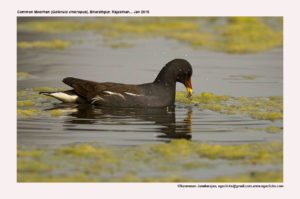Common Moorhen

Common Moorehen Gallinula chloropus
Etymology :
- Gallinula : Latin word for moorhen or waterhen, so named for its cocked tail and halting progress
- Chloropus : Greek word khlōros -green; podos- foot.
Vernacular Names: Hindi: Samanya Jal murghi, Murghaabi, Boder, Urdu: Murghaabi, Sans: Bharat ambukukkuti, Kash: Tech, Bi: Bodor, Pun: Jal-kukri, Ben: Jal murghi, Dakab paira, Mani: Paat uren/urel, Guj: Jal kukadi, Jalmurghi, Mar: Pan kombdi, Kali pankombdi, Ta: Tannir kozhi, Kaanaan kozhi, Te: Jumbu kodi, Bolli kodi, Mal: Patta kozhi, Sinh: Wil kukkula
Distribution in India: Widespread resident.
Description: Size of 30–38 cm; wt. of male 249–493 g, wt. of female 192–343 g ; wingspan 50–55 cm. It is a medium-sized gallinule, plumage appearing essentially black at any distance, with prominent yellow-tipped red bill and elliptical red frontal shield, prominent white line along top of flanks, and white lateral undertail-coverts rendered obvious by constant flicking of tail. The nominate race has head and neck to mantle dark slate-grey, head almost black, nape to mantle with olive-brown tinge, rest of upperparts are dark olive-brown to olive-green . The tail is black with slight tinge of olive, glossed green; remiges are mainly dull black, narrow pale line at bend of wing; dark slate below, white feather tips on flanks, rear flanks have olive-brown wash, lateral undertail-coverts are white. The iris is red; legs and feet are bright yellow-green to yellow, upper half of tibia is orange. Both the sexes are similar, but female is smaller. The immature is similar to juvenile, gradually attaining adult bare-part colours. The juvenile has crown, hindneck and upperparts from brown to grey, duller than in adult; underparts are paler, becoming whitish on throat and belly; wings, white flank line, tail and undertail-coverts are like those of adult; iris is brownish, bill and shield are greenish-brown, olive-grey or pinkish; legs and feet are olive-grey. Racial variation mostly involving mainly size, colour of upperparts and upperwing-coverts, and size of bill shield: Race orientalis ( Andaman islands) has relatively large shield.
Habitat: It is found wide range of natural and man-made freshwater wetlands with fringing emergent vegetation; occurs on both still and moving water. Occurs alongside Eurasian Coot at wetland margins but less prone to venture far out into open water. It is found from lowlands to 2400 m.
Food Habits: It eats Omnivorous; proportions of plant and animal food vary. It feeds while swimming and while walking on floating vegetation, either in cover or in open. It also feeds on land, grazing and gleaning over open grass or in arable farmland. In water, obtains food by dipping head, surface sifting, upending and rarely by diving. It gleans insects, seeds and fruits from ground and plants; often clambers over leaves and stems; climbs and perches well. It Kleptoparasitizes other birds. It is normally diurnal, but sometimes active on moonlit nights.
Breeding Habits: They breed in Indian Subcontinent, Mar–Sept. They rear up to three broods per season, interval between broods 20–30 days. They are monogamous and territorial; territory may be permanent; pair-bond is sometimes maintained for several years. They are polyandrous trios of one female and two males also occur. The nest is saucer-shaped, made of twigs, reeds, rushes and sedges, with shallow to deep cup; often built in emergent vegetation or on solid platform of branches or matted vegetation, in water; sometimes floating. The floating nests often have entrance ramp. Both the sexes build the nests, helped by other group members; material is added during incubation; also builds brood nests or platforms. They lay eggs 5–9 at daily intervals. The incubation period is 17–22 days done by both sexes. The hatching is synchronous for first clutches and asynchronous for replacements and later clutches. The chicks are fed and cared for by both parents, by immature of previous broods and by other adults in group. Brood division may occur; chicks use spur on alula to climb and grasp vegetation, and to enter brood nests. The chicks are brooded frequently until 14 days old; become self-feeding at 21–25 days, but fed for up to 45 days. The fledging period is 45–50 days.